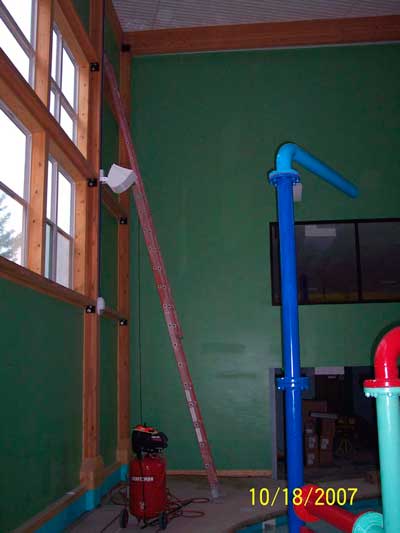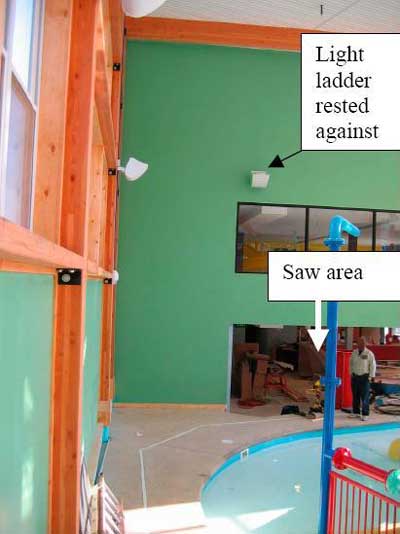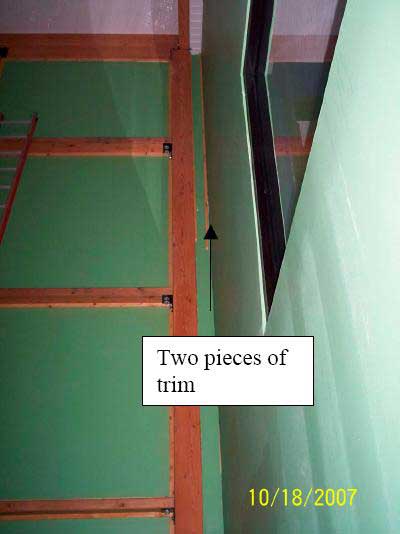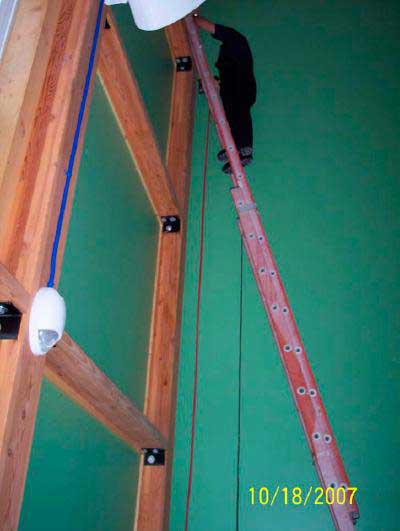Hotel Assistant Manager Dies Due to a Fall from a Ladder During Installation of Wood Trim
Michigan Case Report: 07MI136
Summary
On October 17, 2007, a 28-year-old male hotel assistant manager died when he fell approximately 20 feet from a fiberglass ladder. The hotel was undergoing renovation. Company A, which also owned the hotel, was acting as the general contractor for the hotel’s renovation. Company A had two individuals (Co-owner #1 and Co-owner #2) on site at the time of the incident. Company A had subcontracted the trim work to a local contractor. This local contractor had not completed the trim installation on the west wall of the addition. One of the co-owners of Company A (Co-owner #1) noted the decedent cutting and staining several pieces of 10-foot-long wood trim in the saw area adjacent to the area where trim still needed to be installed. Co-owner #1 was called away from the saw area by Co-owner #2. Co-owners #1 and #2, who were both related to the decedent, were unaware that the decedent had placed a 28-foot extension ladder against the wall to be trimmed. The decedent ascended to the top of the ladder and using a nail gun, installed two sections of trim, beginning the trim installation at the wall/ceiling junction. The fall event was unwitnessed. Co-owner #1 found the decedent on the floor between the ladder and the west wall. The ladder was found leaning against a light fixture approximately 10 feet away. Emergency response was called. The decedent was transported to a local hospital where he subsequently died.

|
|
Figure 1. Police photo of incident scene one day after incident
|
Recommendations:
- Employers should review ladder inspection, placement, and safe use procedures with all employees, including experienced employees.
- Construction employers should develop and implement an accident prevention program that complies with MIOSHA requirements.
Introduction
On October 17, 2007, a 28-year-old male hotel assistant manager died when he fell from a 28-foot fiberglass ladder. On October 29, 2007, MIOSHA was notified of the fatality and informed MIFACE personnel the same day. MIFACE accompanied the MIOSHA compliance officer on a site visit on October 31, 2007, and asked Co-owner #1 of Company A, a family member of the decedent, if Company A would be interested in participating in the MIFACE research program. The co-owner agreed to participate. After interviewing Co-owner #1, the MIFACE researcher and MIOSHA compliance officer were escorted to the incident location. The MIFACE researcher was permitted to take pictures of the incident site. During the writing of this report, the death certificate, medical examiner report, police report and pictures, and MIOSHA file and citations were reviewed. Pictures used as Figures 1, 3, and 4 are courtesy of the responding police department, and were taken one day after the incident. The MIFACE researcher took the picture used for Figure 2 at the time of the site visit.
Company A was functioning as the general contractor for the remodel/addition to the hotel. Company A also owned the hotel. The decedent had worked as an assistant manager for the hotel for five to six years. He was the “administrative” person. He performed the hotel staff hiring, maintained the computers, purchased equipment, etc. The hotel had approximately 14 employees. These employees were not involved in the construction project except to clean up after completion of each section. The decedent, who worked full-time for the hotel, did not have established work hours. Co-owner #1 indicated that the decedent usually arrived between 8:00 a.m. and 9:00 a.m.
Co-owner #1 indicated that he and the decedent were responsible for implementation of both Company A’s construction safety program and the hotel’s safety program. MIOSHA compliance personnel had conducted a site visit several months previously and found that Company A did not have a construction safety program. Company A subsequently adopted the MIOSHA sample construction safety program, but had not “filled in the blanks” nor implemented it at the construction site. Co-owner #1 indicated that he had talked about the safety program with the decedent and that he and the decedent had read the MIOSHA-provided safety program. At the time of MIOSHA’s initial site visit after the fatality, Co-owner #1 could not find the program. Prior to the joint MIOSHA/MIFACE site visit, Co-owner #1 found the safety program in a drawer and completed it (filled in the blanks).
According to Co-owner #1, the decedent had approximately 10 years of experience using a ladder in various construction and hotel-oriented activities. Co-owner #1 indicated that the decedent had been “up and down ladders” numerous times, and had placed ladders against structures both indoors and outdoors on many occasions. Co-owner #1 stated he had not conducted ladder safety training with the decedent because of the level of ladder experience the decedent was perceived to have, and due to the fact that he was “family.”
MIOSHA Construction Safety and Health Division issued one Serious citation and one Other -than-Serious citation to the employer at the conclusion of its investigation.
- SERIOUS:
- FIXED AND PORTABLE LADDERS- PART 11, RULE 1112(1). The employer did not provide a training program for each employee who uses a ladder.
- OTHER-THAN-SERIOUS:
- MICHIGAN OCCUPATIONAL SAFETY AND HEALTH ACT, ACT 154, P.A. 1974, AS AMENDED, RULE 4080.1061(1). The employer did not report orally or in writing to the Michigan Occupational Safety and Health Administration within eight hours after the occurrence of an employment accident or illness, which was fatal to one or more employees or resulted in the hospitalization of three or more employees.
Investigation
The hotel addition/remodel began in January 2007. Company A hired subcontractors to perform the work. The trim subcontractor left the jobsite several months earlier without completing all of the contracted work. The decedent, Co-owner #1 and Co-owner #2 were on site performing “odds and ends” jobs, similar to “punch” work. Co-owner #1 indicated that the ladder was inspected on a regular basis for deterioration. If a ladder showed signs of deterioration, it was discarded.
Co-owner #1 indicated that the usual procedure to perform work from a ladder was to have two people involved when ascending a ladder to that height. One individual was assigned to hold the ladder while the other individual performed the work. The ladder was equipped with safety feet.
 |
|
Figure 2. Work area of decedent
|
On the day of the incident, Co-owner #1 noticed the decedent in the saw area cutting and staining 10-foot long wood trim pieces. The saw area was located approximately eight feet away from the west wall on a lower level accessed by two stairs. The decedent had cut and stained eight pieces of trim.
Co-owner #1 was called away from the saw area by Co-owner #2. While Co-owner #1 and Co-owner #2 were in another area of the jobsite, it appears the decedent placed the fiberglass ladder, extended to 24 feet 3 inches, against the west wall near the junction of the west wall and the north wall. He took two pieces of stained trim to the renovation area and left the remainder of the stained trim in the saw area (Figure 2 ).
 |
|
Figure 3. Placement of trim on west wall.
|
The sequence of events leading to the fall was unwitnessed. The decedent placed the base of the ladder approximately five to six feet away from the west wall. He ascended the ladder carrying the nail gun and trim to the wall/ceiling junction. Using the nail gun, he nailed two pieces of trim (Figure 3). The last nail on the trim was located 23 feet, 1 inch from the floor. Based upon the last nail position, it was estimated that the decedent fell approximately 20 feet to the concrete floor.
Co-owner #2 returned to the area and found the decedent on the ground between the ladder and the north wall. The ladder was found tipped “backwards” and held in an upright position by a light fixture on the north wall. The nail gun was found on the floor. Co-owner #2 called out to Co-owner #1 to come quickly and call 911. Emergency response arrived and transported the decedent to a local hospital where he died approximately one hour later.
The responding police department performed a re-enactment of the work the decedent was performing to show the nail gun’s air hose and hose slack, location of ladder, and height of the decedent’s fall (Figures 1 and 4 ).
 |
|
Figure 4. Police photo of postulated position of decedent on the ladder at the time of the fall
|
Back to Top
Cause of Death
The cause of death as stated on the death certificate was blunt force chest trauma. Autopsy results were negative for alcohol and illicit drugs.
Back to Top
Recommendations/Discussion
Employers should review ladder inspection, placement, and safe use procedures with all employees, including experienced employees.
Many safety experts recommend that a ladder should be used primarily to climb to or from a work area, not as a work platform. In this case, the employer was limited in his options to use an alternative work platform such as an aerial lift or scaffold because of the location of the pool and saw area. Safe ladder use requires a worker to maintain a three-point connection (two hands/one foot or two feet/one hand) and his/her shoulders within the side rails. In this case, the decedent was not able to maintain a three-point connection because he was required to use both hands to hold and nail the trim into place.
In violation of the company’s usual procedure, the decedent performed the work without the assistance of another individual stabilizing the ladder. Employers should not hesitate to reinforce safe ladder use practices with experienced ladder users. Workers who perform hazardous tasks may develop a cavalier attitude over time. Workers’ attitudes and motivations impact their work practices as well as their knowledge of how to do the work.
The workers’ knowledge of the safe and correct way to work plus knowing that the employer expects that the work will be conducted safely and correctly should be emphasized in worker training. Reinforcement of the importance of safe work procedures and the expectation that they would be followed is an important element in the prevention of injuries. One method employers could use to reinforce the importance of safe work procedures and requirements of existing safety standards and company policy would be to provide refresher safety training programs throughout the year. A review of the specific hazards of the tasks the workers would be expected to perform and periodical monitoring of the workers would provide the employer with some confidence that the work assigned was being conducted in an appropriate manner.
MIOSHA Construction Safety Standard, Part 11, Fixed and Portable Ladders contains the State requirements for safe ladder use, including employee training requirements. In addition, many organizations have published and/or posted on the Internet safe ladder use practices. Examples include:
- University of Nebraska – Lincolnpdf iconexternal icon. Internet Address: (http://ehs.unl.edu/sop/s-ladder.pdf),
- OSHA Construction e-Tool: Misuse of Portable Ladders.external icon Internet Address: (www.osha.gov/SLTC/etools/construction/falls/ladders.html),
- Center to Protect Workers Rights Portable Ladder Safety Hazard Alert. Internet Address: (www.buildsafe.org/hazalerts/hazladders.pdf). (Link no longer available 3/25/2013)
- Bowling Green Environmental Health and Safety: Portable Ladder Safety (PowerPoint Presentation): Internet Address: (http://www.bgsu.edu/downloads/finance/file21420.ppt) (Link no longer available 4/9/2015)
Construction employers should develop and implement an accident prevention program that complies with MIOSHA requirements.
MIOSHA Construction Safety and Health Division had previously cited the employer for not having a written and implemented safety program. Prior to the incident, the company owner and decedent had read the sample plan, but had not completed nor implemented the program requirements. As a general safety recommendation to reduce the risk of injury, employers should ensure that a safety program is both comprehensive and implemented and ensure that all employees are trained to recognize and avoid hazardous work conditions.
A comprehensive safety program should address all aspects of safety related to specific tasks that both the employer and employee are required to perform. MIOSHA Construction Safety Standard, General Rules, Part 1 requires employers to develop an accident prevention program and instruct employees in the recognition and avoidance of unsafe conditions. Enforcement of this safety program should reduce and/or eliminate worker exposures to hazardous situations. The safety program should include, but not be limited to, ladder safety, the use of safety equipment, and the recognition and avoidance of fall hazards.
The MIOSHA Consultation Education and Training (CET) Division has developed a Sample Construction Safety Program to assist in developing a site-specific program. This program may be downloaded from the MIOSHA websiteexternal icon: www.michigan.gov/mioshastandards. Click on Publications, Forms and Media in the box at the left, then click Construction Safety Program, SP#1.
References
MIOSHA standardsexternal icon cited in this report may be found at and downloaded from the MIOSHA, Michigan Department of Labor and Economic Growth (DLEG) web site at: http://www.michigan.gov/mioshastandards. MIOSHA standards are available for a fee by writing to: Michigan Department of Labor and Economic Growth, MIOSHA Standards Section, P.O. Box 30643, Lansing, Michigan 48909-8143 or calling (517) 322-1845.
- DLEG MIOSHA Construction Safety Standard, Part 1. General Rules.
- DLEG MIOSHA Construction Safety Standard Part 11, Fixed and Portable Ladders.
- MIFACE INVESTIGATION REPORT: #02MI119. Inside Wireman Electrician Electrocuted Working on Exterior Light Polepdf iconexternal icon. Internet Address: http://www.oem.msu.edu/MiFace/02MI119v1.pdf
Michigan FACE Program
MIFACE (Michigan Fatality Assessment and Control Evaluation), Michigan State University (MSU) Occupational & Environmental Medicineexternal icon, 117 West Fee Hall, East Lansing, Michigan 48824-1315. Internet Address: http://www.oem.msu.edu/MiFACE_Program.aspx. This information is for educational purposes only. This MIFACE report becomes public property upon publication and may be printed verbatim with credit to MSU. Reprinting cannot be used to endorse or advertise a commercial product or company. All rights reserved. MSU is an affirmative-action, equal opportunity employer. 4/30/08 (Link updated 8/5/2009)
MIFACE Investigation Report # 07MI136 Evaluationpdf iconexternal icon (see page 8 of report)
To contact Michigan State FACE program personnel regarding State-based FACE reports, please use information listed on the Contact Sheet on the NIOSH FACE web site Please contact In-house FACE program personnel regarding In-house FACE reports and to gain assistance when State-FACE program personnel cannot be reached.
